The Nostalgic Yet New Face of Nihonbashi as Depicted by an Illustrator Who Loves Downtowns: What is the “Reiwa Shin-Hanga” Project That Seeks to Revive Ukiyo-e in Our Era?
The Nostalgic Yet New Face of Nihonbashi as Depicted by an Illustrator Who Loves Downtowns: What is the “Reiwa Shin-Hanga” Project That Seeks to Revive Ukiyo-e in Our Era?
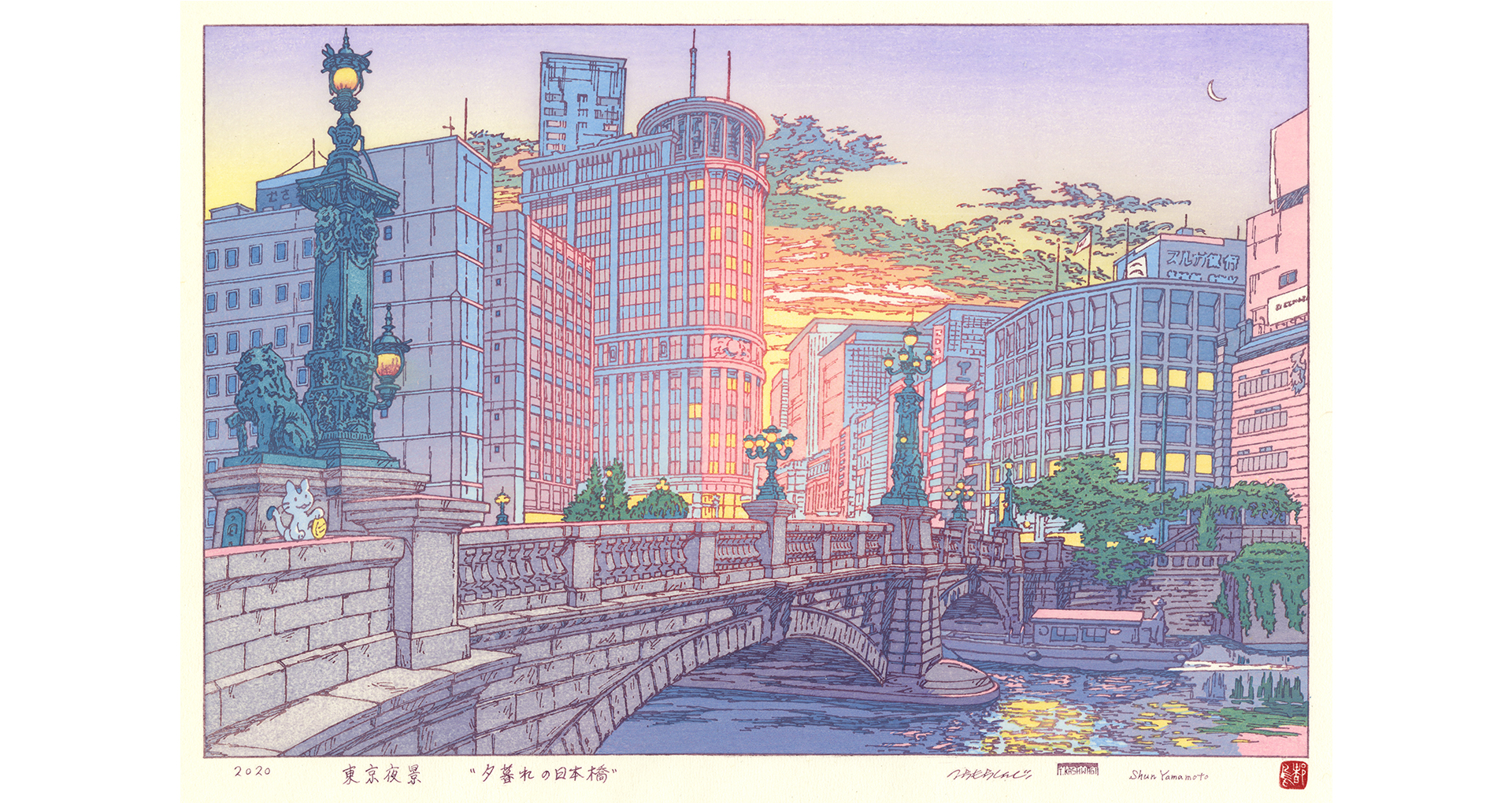
The piece Twilight at Nihonbashi depicts a sunset over the city through parting clouds, with a mixture of past and future elements. While retaining a grounding in traditional ukiyo-e woodblock prints, it incorporates modern techniques and expressive elements in its production, for a modern version of historic Japanese ukiyo-e. The illustrator behind it is one Mr. Shinji Tsuchimochi, who specializes in depicting downtown landscapes that give a sense of newness amid familiar elements. Mr. Tsuchimochi participated and helped plan the “Reiwa Shin-Hanga” (or “new hanga art for the Reiwa era”) project to revive ukiyo-e in the modern era, and published a collection titled The Works of Shinji Tsuchimochi – UKIYO in February 2020. For this issue, we spoke with Mr. Tsuchimochi about the “Reiwa Shin-Hanga” project, with his aims of creating a new ukiyo-e movement, and also about his feelings for Twilight at Nihonbashi.
From the past to the future – depicting Nihonbashi while contemplating the flow of time
-The piece Twilight at Nihonbashi has a faintly nostalgic mood, with its relaxed atmosphere. Why did you decide to create it, and what are your feelings toward the piece?
I often go for walks in Nihonbashi on my lunch break, since my office is nearby. It has a mix of tall buildings with western architecture and traditional, established business, as well as boat traffic near road traffic, making it a fun neighborhood. Also, it used to be a hub for people going back to the Edo era (1603-1868), and more recently redevelopment has made headway and it has become a popular area for younger people. I wanted to depict a city with the area’s unique atmosphere, where new elements coexist with things handed down over the ages. I had actually done a piece on Nihonbashi in the past, too, but it was a more dynamic, fantastical nighttime piece. So I wanted to express another side of Nihonbashi here, and I went with the quiet period just as day turns into night.
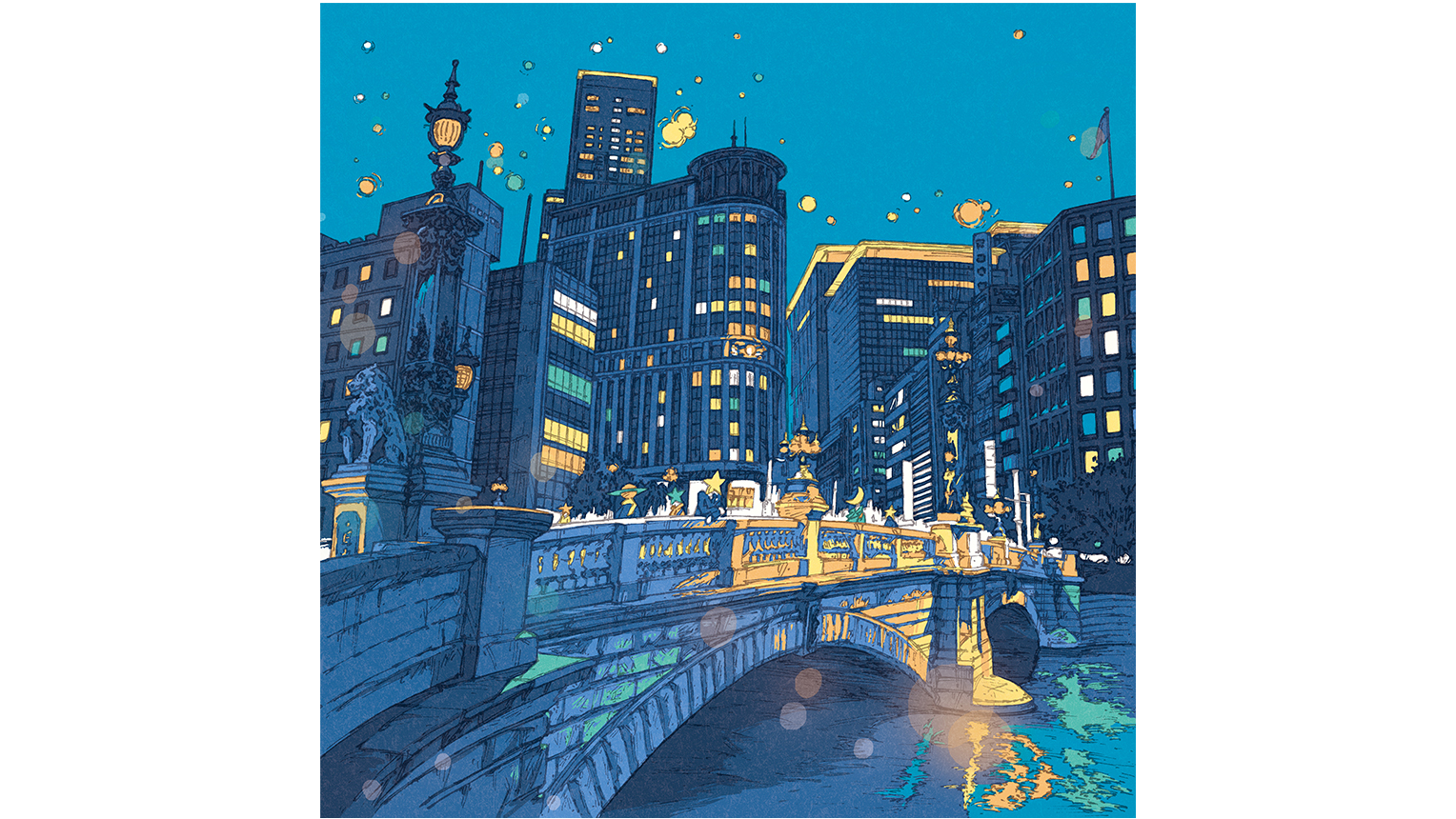
Tokyo Metropole/Nihonbashi, Mr. Tsuchimochi’s depiction of the city prior to Twilight at Nihonbashi
-Neither of Twilight at Nihonbashi or this nighttime piece shows the highway over the city; why is that?
That’s simple, it’s because I wanted to create expressive art from the scenery, without the highway in it. Countless artists have depicted Nihonbashi, going back to Hiroshige Utagawa, the Edo-era ukiyo-e artists. I wanted to try to depict the same Nihonbashi, as it used to be. While I was aiming for something that might also come across as the future, leaving out the highway keeps it nostalgic.
-Does Nihonbashi have any other faces you’d like to work with, in the future?
I’ve done the night time and twilight, so next would be dawn. I’d also like to try a morning scene with people in transit, and individual scenes. I like art that gives a sense of time lapsed for how it has a sense of time and space moving by, making it distinct. And I’d like to try inverting that and depicting its future, since Nihonbashi used to be this specific sort of place. It’s an appealing area that makes me want to draw it from all sorts of angles.

Mr. Tsuchimochi works in the Nihonbashi area on weekdays. He also produces illustrations for two or three hours before work each day, and on the weekends
-With Twilight at Nihonbashi as a prominent example, all of your works depict the present day in a somehow nostalgic way, Mr. Tsuchimochi. Could you tell us about how you find your subjects for artworks, and your process and so on?
I like to walk through the city, and I find places I want to use as subjects particularly often downtown. I like how they feel nostalgic or give people a sense of déjà vu in isolation. I focus on works that will blend with personal memories, such that people will recall another scene from them even if they don’t know the location in the piece. I want them to cling close to the thoughts and feelings of each viewer. I communicate with the viewers through the scenery I depict. That’s my ideal.
I also try to add a single idea as a game for myself, like a character or a monster. In Twilight at Nihonbashi, it’s a maneki-neko lucky cat. I just want people to notice them, but I hide them away in my art (laughter). That’s probably another aspect of my desire to communicate through my art.
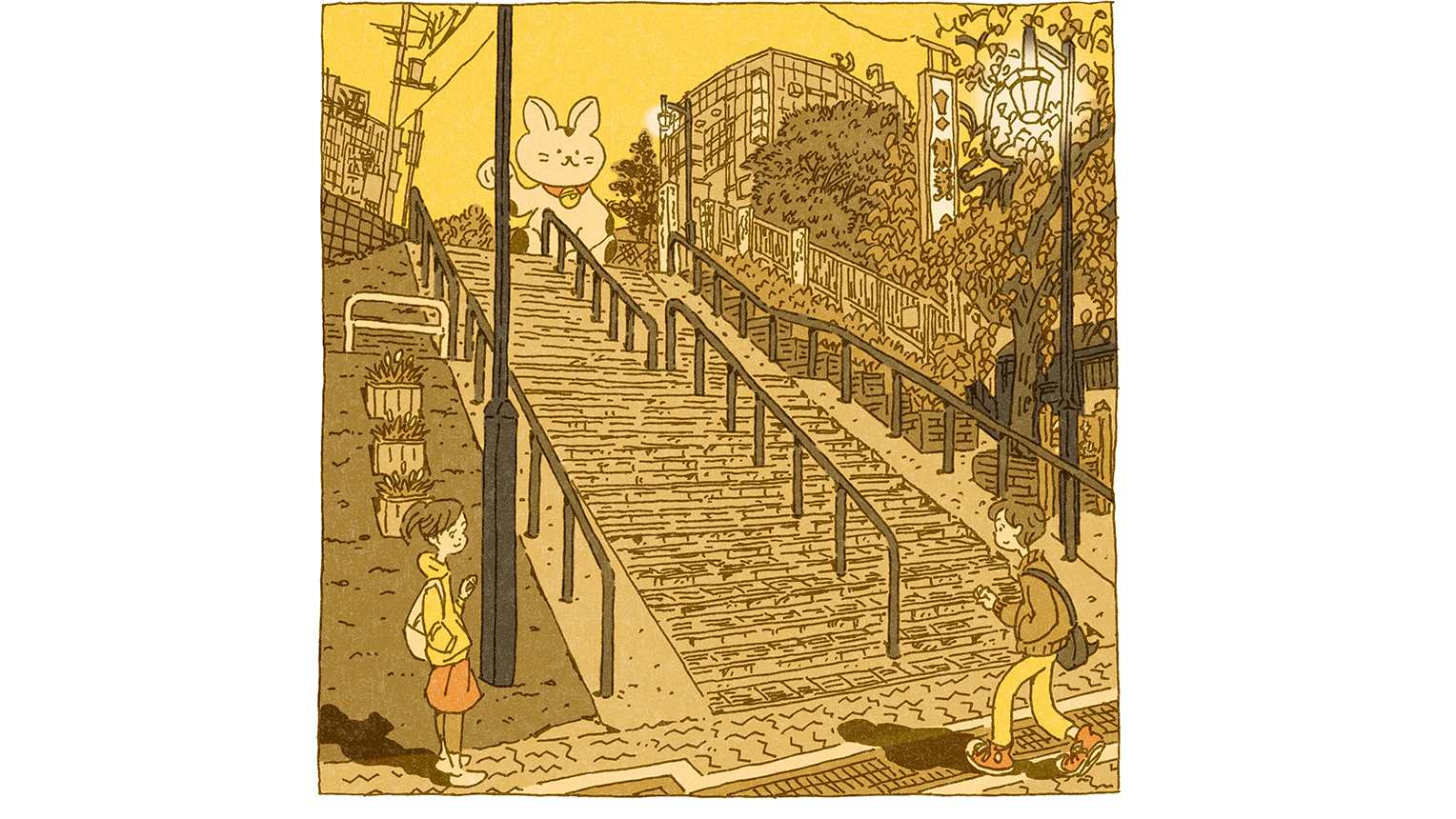
Yuyake Dandan/Taninaka from the 100 Views of Tokyo art compilation
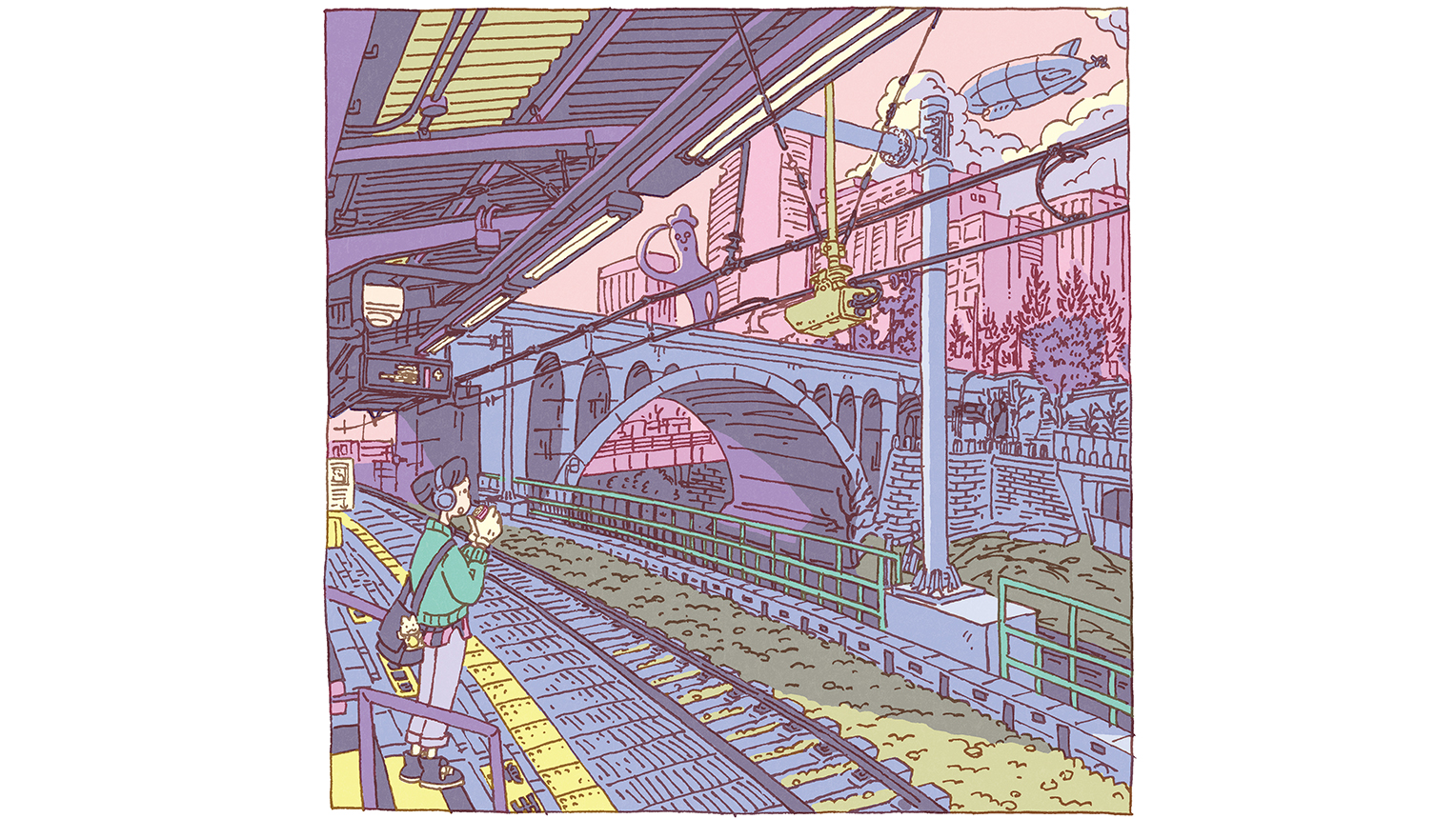
View 30 Hijiribashi Bridge/Yushima 1 from the 100 Views of Tokyo art compilation. You can see playful elements on a closer look
-I’ve heard you produced Twilight at Nihonbashi as part of your “Reiwa Shin-Hanga” project. What does the project involve?
Mr. Takashi Kashiwagi of the publisher “Miyakodori” launched the “Reiwa Shin-Hanga” project. Mr. Kashiwagi is descended from an ukiyo-e artist, and is premised on an effort to produce “Reiwa Shin-Hanga” ukiyo-e artwork suited to the modern era, in order to help future generations connect with the art style as its creators dwindle in number. For the record, shin-hanga refers to a revival that preserves Edo-era ukiyo-e, like the woodblock prints produced in the Taisho (1912-1926) and early Showa (1926-1989) eras.
You make traditional ukiyo-e individually, by hand-carving the wood blocks for printing, but “Reiwa Shin-Hanga” are updated. They use laser cutters to carve the blocks with three-dimensional, modern motifs. The project is about producing modern ukiyo-e with new wood blocks unlike anything in the past. I joined the project as an artist on Mr. Kashiwagi’s request, and Twilight at Nihonbashi is one of the pieces I produced.
The fun of three-dimensional expressions and designs – sharing the appeal of shin-hanga through personal works.
-Could you tell us about how you learned art techniques and developed your current style, Mr. Tsuchimochi?
I liked drawing manga comics as a child, and was heavily influenced by Van Gogh when I studied art in middle and high school. Van Gogh loved ukiyo-e and incorporated elements of it into his works, so his art led to my interest in ukiyo-e. I went to an art university after that, and wanted to learn more about things like ukiyo-e that I could only learn in Japan, so I majored in Japanese art. But I mostly had to paint using mineral pigments (pigments for Japanese artwork made using powdered minerals) in college, so I never got a chance to learn about ukiyo-e, even though it was my original interest. That means I ended up developing artwork purely through individual study and personal stylistic interpretations, based on ukiyo-e.
-How does ukiyo-e appeal to you, Mr. Tsuchimochi?
The genre of ukiyo-e that actually really enthralls and inspires me is the one I mentioned a bit ago, “shin-hanga.” Shin-hanga came about right at the time that the Japanese art world was rocked by a wave of westernization. The style has famous artists like Hasui Kawase, and was more popular abroad than within Japan given the impact of the Japonisme trend in the west at the time. Even in this era, it’s public knowledge that the late Princess Diana and Steve Jobs both collected shin-hanga.
The way you draw pictures is the big difference between shin-hanga and Edo-era ukiyo-e. Rather than the flat, simplistic style unique to ukiyo-e, shin-hanga uses light and darkness to produce a three-dimensional look that can be confused with watercolors. Each piece looks different from different angles, making them more intriguing the more you view them. Also, they include a complex interplay between Japanese elements and western elements that came with the cultural opening of Japan, making them a very unique artistic blend of east and west. Shin-hanga’s appeal as the successor to ukiyo-e is the fascinating subjects and the fun of the three-dimensional, expressive style. I want to convey the appeal of both of those aspects with my own works.
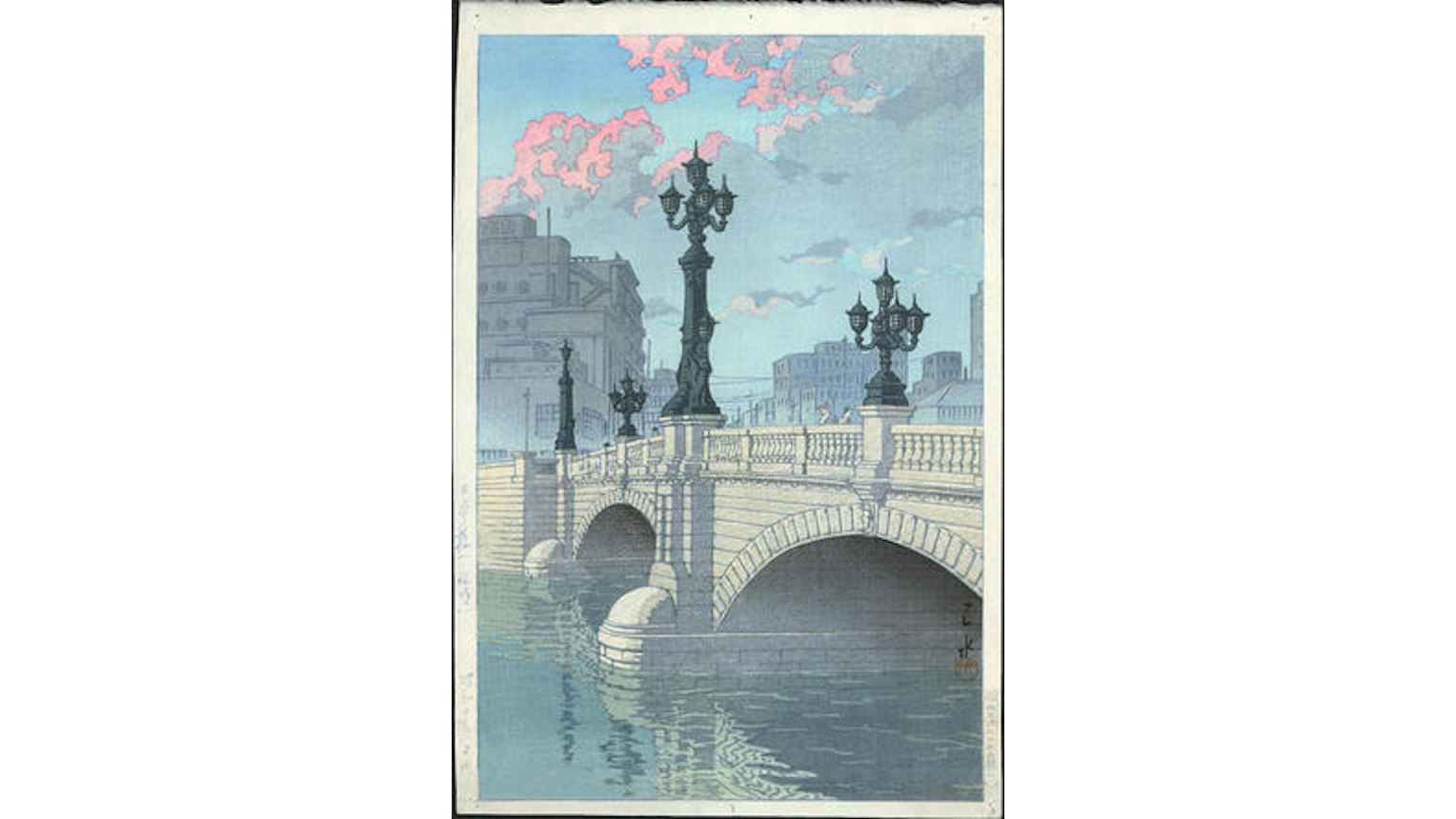
Dawn at Nihonbashi Bridge by Hasui Kawase, once a prominent shin-hanga artist (Source: Japanese Art Open Database)
-Was there anything in shin-hanga that connected with your own personal works?
Shin-hanga use a distinct style with dozens of layers of gradation, so once I learned of the style, I felt I could use the delicate design techniques I learned for Japanese painting to produce the light and shadow for shin-hanga. Also, it seemed like my manga-style touches would fit into it well, so I wanted to produce works using shin-hanga techniques, and was driven to learn more about the style. While I was searching for ways to do that, someone from the “Reiwa Shin-Hanga” project approached me about reviving ukiyo-e, and my dream really came true.
Reviving ukiyo-e in the modern era through a major collaboration.
-Could you give us more details on your process for producing art in the “Reiwa Shin-Hanga” project?
For shin-hanga, the artist first creates the design sketch, the carver creates a block, then the printer prints it, as a process. In the “Reiwa Shin-Hanga” project, we sometimes incorporate new technology into some points of that. For example, I created digital sketches like I would for any other artwork, then had them made into blocks with a laser cutter. The hard part was getting the right concentration of pigments when converting the digital image to a hanga wood block print. I talked with the printer and publisher repeatedly about how to get it right, did multiple trial runs, and finally arrived at the right coloration. It was a lot of work, but the process itself was also a ton of fun.
I normally produce art all on my own, but modern ukiyo-e is a team effort. Producing a piece in collaboration with many other people was a fresh experience for me. The finished version is my artwork, but it’s not mine alone. It was deeply emotional for me when we finished Ginza in the Rain and Twilight at Nihonbashi, with so many people and processes involved. It made it clear for me that I want to express things like these pieces in the future, and I’m proud to have made progress in learning ukiyo-e techniques. At the same time, producing pieces also made me feel that there might be more proper ways of producing hanga-style sketches, so I have a lot of studying I’d like to get into on that front.
Scenes of the “carving” and “printing” processes. Even modern ukiyo-e carries on traditional printing techniques, and artists say a skilled printer can produce anything
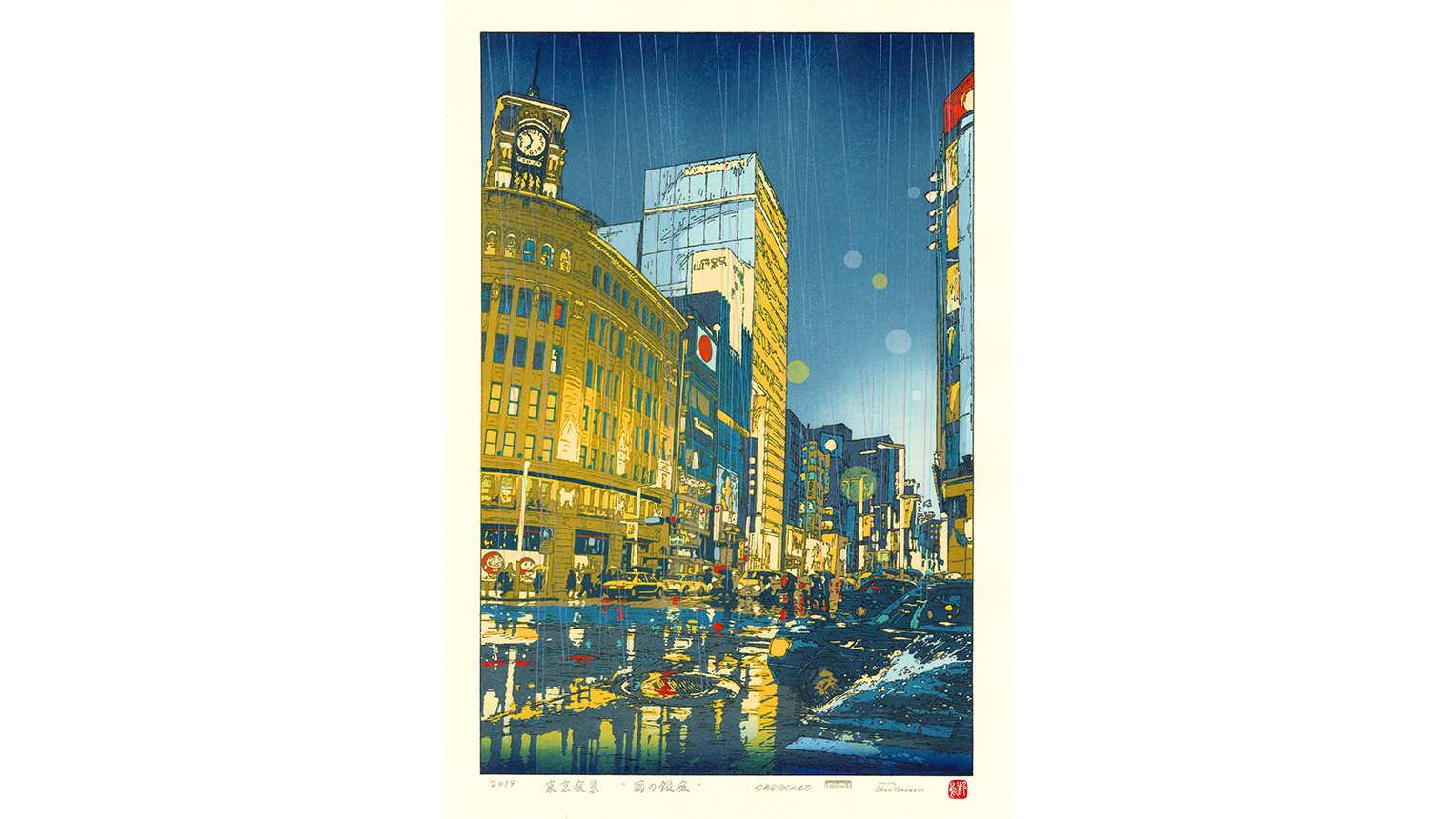
Ginza in the Rain/Tokyo Nightscape, a piece from the “Reiwa Shin-Hanga” project. It uses advanced polarized pigments with colors that shift based on the viewing angle and background color to expressively convey the rain
-Could you tell us about your hopes for the future of the “Reiwa Shin-Hanga” project and your personal ambitions, Mr. Tsuchimochi?
I joined in the “Reiwa Shin-Hanga” project as a single artist, but I’m a core member now, and I’m also involved in selecting and supporting other artists. I think we need a shift in values to make tradition more present in peoples’ lives in order for them to connect with it. To do that, I want to get the project to build momentum first, then I want to start spreading it further and increasing the number of young artists involved aside from me. So I want artists who focus on everything from beautiful women to beautiful natural scenery to join us, and then I want to work to find ways to make their sketches into hanga artwork. I’d also be delighted if they became famous for making hanga art.
I also think that people need to get familiar with ukiyo-e and shin-hanga art by viewing it in order for it to be more a part of their lives, just like when listening to popular music. For example, I want to create a place on social media or something like that for young people casually encounter art and artists. We had a shin-hanga exhibition in August of 2020, and I got a real sense of how important it is to get people to see the real thing. I want to create more spaces and opportunities like that, in the future. I’m aiming to set of a new ukiyo-e art movement.

Mr. Tsuchimochi, holding Twilight at Nihonbashi. He says he will focus even more on the “Reiwa Shin-Hanga” project in the future, in order to create a movement that keeps ukiyo-e alive for future generations
Interview and text: Makiko Kojima, photography: Daisuke Okamura
Shinji Tsuchimochi
An illustrator born in Tokyo. He produces artwork for CD jackets, book illustrations, and TV programs with touches that evoke ukiyo-e. He has published the works 100 Views of Tokyo in 2016 and The Works of Shinji Tsuchimochi – UKIYO in 2020 (both from Shikaku Publishing). He focuses on artwork that incorporates shin-hanga techniques as a member of the “Reiwa Shin-Hanga” project.(※You can buy "Miyakodori" artwork by following this link https://miyakodori.booth.pm/)




